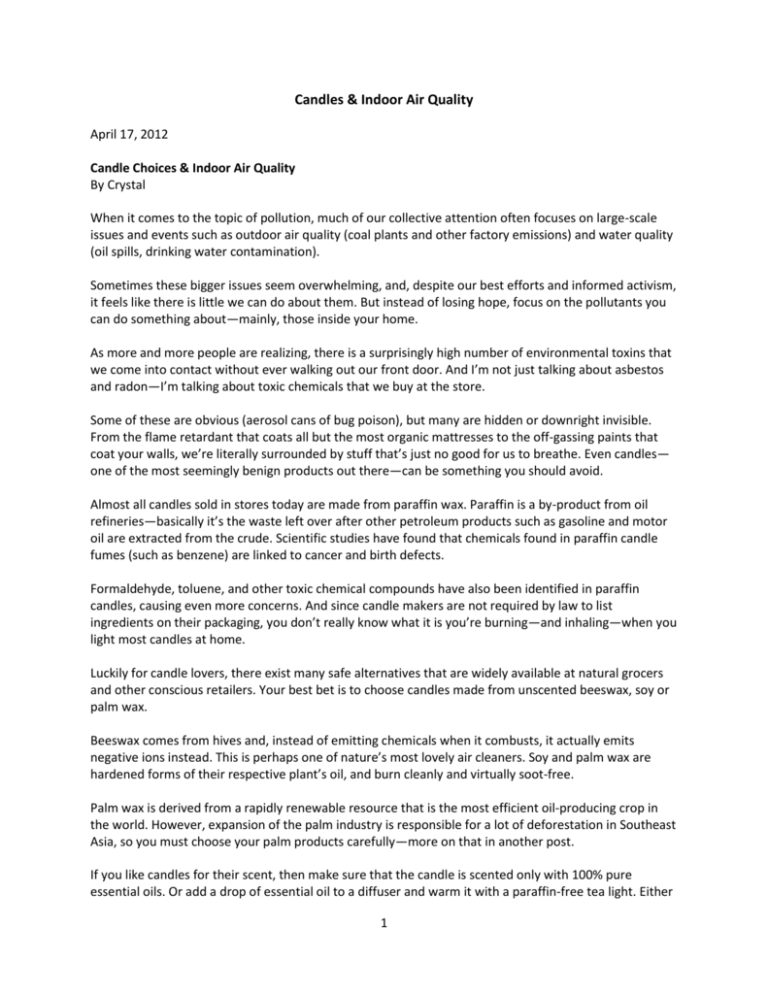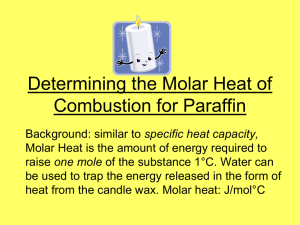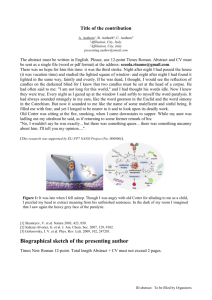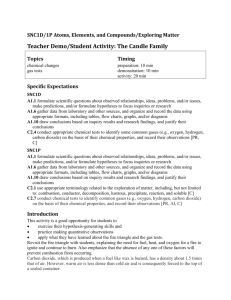Candles & Indoor Air Quality
advertisement

Candles & Indoor Air Quality April 17, 2012 Candle Choices & Indoor Air Quality By Crystal When it comes to the topic of pollution, much of our collective attention often focuses on large-scale issues and events such as outdoor air quality (coal plants and other factory emissions) and water quality (oil spills, drinking water contamination). Sometimes these bigger issues seem overwhelming, and, despite our best efforts and informed activism, it feels like there is little we can do about them. But instead of losing hope, focus on the pollutants you can do something about—mainly, those inside your home. As more and more people are realizing, there is a surprisingly high number of environmental toxins that we come into contact without ever walking out our front door. And I’m not just talking about asbestos and radon—I’m talking about toxic chemicals that we buy at the store. Some of these are obvious (aerosol cans of bug poison), but many are hidden or downright invisible. From the flame retardant that coats all but the most organic mattresses to the off-gassing paints that coat your walls, we’re literally surrounded by stuff that’s just no good for us to breathe. Even candles— one of the most seemingly benign products out there—can be something you should avoid. Almost all candles sold in stores today are made from paraffin wax. Paraffin is a by-product from oil refineries—basically it’s the waste left over after other petroleum products such as gasoline and motor oil are extracted from the crude. Scientific studies have found that chemicals found in paraffin candle fumes (such as benzene) are linked to cancer and birth defects. Formaldehyde, toluene, and other toxic chemical compounds have also been identified in paraffin candles, causing even more concerns. And since candle makers are not required by law to list ingredients on their packaging, you don’t really know what it is you’re burning—and inhaling—when you light most candles at home. Luckily for candle lovers, there exist many safe alternatives that are widely available at natural grocers and other conscious retailers. Your best bet is to choose candles made from unscented beeswax, soy or palm wax. Beeswax comes from hives and, instead of emitting chemicals when it combusts, it actually emits negative ions instead. This is perhaps one of nature’s most lovely air cleaners. Soy and palm wax are hardened forms of their respective plant’s oil, and burn cleanly and virtually soot-free. Palm wax is derived from a rapidly renewable resource that is the most efficient oil-producing crop in the world. However, expansion of the palm industry is responsible for a lot of deforestation in Southeast Asia, so you must choose your palm products carefully—more on that in another post. If you like candles for their scent, then make sure that the candle is scented only with 100% pure essential oils. Or add a drop of essential oil to a diffuser and warm it with a paraffin-free tea light. Either 1 way, it is not wise to burn candles scented with synthetic fragrances. When those combust, they may release the hard-to-spell phthalates, which are hormone disruptors. Also, make sure that the wick does not contain lead or any other filament. There are many choices we can make at the store that can have a big impact on our lives and the health of our families. Switching to beeswax, soy, or palm wax candles is an easy yet important way to greatly improve the air quality in your home, and to improve the quality of the lives of those who are chemically sensitive or suffer from allergies. http://www.happy-mothering.com/04/household/decor/candle-choices-and-indoor-air-quality/ ---------August 21, 2009 Study: Some types of candles may pollute indoor air By Kate Stinchfield A soak in a steamy tub, surrounded by candles sure seems like a great way to unwind. But new research suggests that burning certain kinds of candles may generate indoor air pollutants. Researchers at South Carolina State University studied petroleum-based and vegetable-source candles to determine their emissions. They let candles from different manufacturers burn for up to six hours in a small box (8 inches x 8 inches x 26 inches), and then collected and analyzed substances released into the air. They found that paraffin-based candles -- the most popular kind -- emitted toxic chemicals like toluene and benzene. Soybean candles did not, according to the study, which was presented this week at the American Chemical Society meeting in Washington, D.C. Candles made of beeswax or soybean tend to make mention of that ingredient on their label; paraffin candles may not. The researchers say that lighting a paraffin candle once in a while is unlikely to pose a health threat. However, frequently lighting many candles in an unventilated space could lead to problems, and may aggravate asthma, cause allergy-like symptoms, or irritate the respiratory tract. However, whether some candles are safer than others is still debatable, according to one expert. "I think there's some controversy out there as to which candles are better than others," says George Thurston, Ph.D., an associate professor of environmental medicine at the New York University School of Medicine. Thurston urges people to be prudent about lighting any kind of candle -- whether it's paraffin, beeswax, or soybean -- in an enclosed space. "Just lighting a match to start a candle creates sulfur pollution in the air," he adds. "It's one of the big sources of sulfur in the indoor environment, so using a lighter would probably be cleaner." While you aren't putting your life on the line by lighting a candle, he says you should exercise at least some caution. "You ought to try to minimize your exposure to paraffin wax candles," says Thurston. "And when you light any kind of candle, you might turn on the exhaust fan; even if it ruins the mood, it vents out the fumes. People just need to use common sense." 2 Candles are only one potential source of indoor air pollution. "A lot of household products give off volatile organic compounds, or VOCs," says David Rosenstreich, M.D., the director of the division of allergy and immunology at New York's Montefiore Medical Center. Cleaning products, hair sprays, and mousses all contribute to indoor air pollution. "We live in a highly chemically infused environment where people use tons of products," he adds. "Just because it's on the supermarket shelves doesn't mean it's safe." Central heating and cooling systems, as well as gas fireplaces, can generate indoor air pollution too. "People have these fake fireplaces that are unventilated and the pollution just sits in the room," says Thurston. "You need ventilation, just like you do with candles." People with respiratory problems such as asthma and chronic obstructive pulmonary disease should make an extra effort to cut down on indoor air pollution, says Rosenstreich. And it's easier than it sounds. "You can wipe down your counter with a little soap and water," he says. "You don't need to use these powerful cleaners." He also suggests ventilating your home as naturally as possible by opening the windows at night once the house has cooled down. "That way you're not breathing in the same old stale air," he says. If you are prone to outdoor allergies, use a filter in your central air and heating systems to cut down on dust. Simply thinking twice about the chemical products you use in your home can go a long way toward improving air quality. "A lot of things we take for granted aren't really safe at all," Rosenstreich says. Barbara Miller, a spokesperson for the National Candle Association, says "no candle wax has ever been shown to be dangerous or harmful to human health." "Paraffin wax is neither toxic nor carcinogenic," says Miller. "All types of properly formulated candle wax have been shown to burn cleanly and safely." She notes that a 2007 industry-funded study found that none of the candle waxes tested -- including paraffin, soy wax, and beeswax -- produced benzene. The levels of volatile organic compounds were less than 2 percent of the indoor air-quality standard. In that study, nine 6-ounce candles of each type containing no fragrance or dyes were burned simultaneously in a test chamber. The test simulated four hours of daily burning of one container candle in a room about 1765 cubic feet (50 cubic meters) in size. http://articles.cnn.com/2009-08-21/health/candles.air.pollution_1_candles-indoor-airpollution?_s=PM:HEALTH ---------The Dangers of Paraffin Candles In 2001 the EPA (Environmental Protection Agency) concluded that burning paraffin candles emit harmful amounts of toxins in the air that are considered above the excess cancer risk with multiple exposures. 3 According to California’s safe drinking water and toxic enforcement act of 1986, there are up to twenty toxins in paraffin candle wax - substances which are found in paint, lacquer and varnish removers. Petro-soot from paraffin candles is the same soot as the exhaust of a diesel engine. Its considered just as dangerous as secondhand smoke from cigarettes, causing problems from headaches to lung cancer. Paraffin fumes have been found to cause tumors in the kidneys and livers of lab animals. In 2005, when the American Lung Association issued a warning to the public about the dangers of paraffin, the National Candle Association (NCA) threatened them with legal action. The NCA has also sent letters to others who tried to warn the public. Paraffin is made from leftover residue of the final petroleum refining process. The wealthy oil industry (which not only sells their by-products to the candle industry, but has four members sitting on the board of the National Candle Association) has assumed a very dominant position in the candle manufacturing business. Additionally, the amounts of particulates, volatile compounds, and soot released into the air increase with: · the type of wick · inclusion of any synthetic fragrant oil scents and/or dyes · flame and combustion. Wicks The purpose of a wick is to draw wax to fuel the flame of a candle. Various types of wick are used for different purposes in candle making. They can be divided into two main categories: cored and non-cored wicks. Non-cored wicks are generally made of a braided or twisted plant fiber (most commonly cotton). These wicks are considered to be the safest to burn. Cored wicks are usually cotton around a paper or metal core. The extra rigidity of the wicks is needed in candles that melt so that the wick is not supported (some container candles, for example). Metal-cored wicks also burn at a higher temperature than pure cotton wicks, which is advantageous with some wax blends that have a high melt temperature. However, metal cores traditionally contained lead. In the early 1970s, the U.S. Consumer Products Safety Commission (CPSC) warned about the dangers of candle wicks containing lead. Although the candle industry agreed to voluntarily stop using lead, a study conducted by a University of Michigan professor in 1999 found about 30 percent of the candles from the United States and overseas still used lead wicks. The CPSC decided in April 2002 to ban the manufacturing, importing, and selling of candles with lead wicks; the regulations became effective in October 2003. Dyes & Fragrances Most candles on the market made from paraffin may also contain other chemical additives in the dyes and fragrances that can be toxic when inhaled. 4 Candle makers are using increasing amounts of fragrance oils in their wax mixtures, some of which are not even suitable for combustion. Too much fragrance, in “triple scented candles” for example, can cause the candle wick to mushroom, smoke when burned, and could even cause the candle itself to combust shooting flames several inches above the candle. Excessive amounts of fragrance oil contribute to soot (referred to as ghosting, carbon tracking/tracing, or dirty house syndrome), a concern when candles are burned indoors. It leaves reside on walls and furniture. Ever noticed the black soot on the jars of some of the well known candle companies? Most commercially manufactured fragrances are formulated in a petroleum base, which emits toxic chemicals when burned. Some scented candles have been found to emit toxins such as acetone, tetrachloroethene, chlorobenzene, ethylbenzene, styrene, xylene, phenol, cresol, cyclopentene, lead, carbon monoxide, particulate matter, and soot. The candle industry is not regulated by the government. Candle manufacturers are not required to list or disclose hazardous, toxic, or carcinogenic compounds used as ingredients in their products. http://www.angelfire.com/planet/soy/Paraffin-dangers.html -------More about Additives Candles often contain additives which change their color, scent, or burning characteristics. While these chemicals can make your candles look and smell nice, they can also release toxins into your house when they are burned. Scents Beeswax and bayberry wax are two naturally scented waxes, beeswax offering the sweet smell of honey and bayberry a spicy, fresh aroma. Scents added to wax vary in their source and composition. Originally, perfumes came from animal and vegetable sources. In the late 1800s the first synthetic fragrances were produced, and were quickly adopted as a cheaper source of aromas. The American Lung Association says: "Refrain from burning scented or slow-burning candles that have additives."Fragrance oils, also known as "FO's", are specially made for particular uses such as scenting candles, soaps and cosmetics, or potpourris. They are usually synthetic (man-made combinations of chemicals). Exact formulas for fragrances fall under the trade secrets act in the U.S., but manufacturers of the oils will normally be able to produce a Materials Safety Data Sheet which will cover the physical characteristics of the oil, physical or health hazards, and first aid treatment in case of an accident. Candle scents contain stabilizers and fixatives which allow the oils to mix with wax and give off an aroma when heated. Essential oils, or "EO's", are naturally-occurring oils that are extracted mainly from botanical sources. They are usually more expensive than synthetic fragrances, and may not blend well with candle wax. They are more volatile than synthetics and most of them are difficult to use in candles unless they have added stabilizers or fixatives. 5 Nature-identical scents are man-made copies of natural oils, using the same chemicals in combination to imitate particular scents. They are usually sold as fragrance oils. Colors There are two types of coloring agents for wax: pigments and dyes. Pigments are concentrated colors not usually used in the interior of candles because their granularity can clog the wick. They are used to dip the exterior of candles for a deeper color than can be achieved with dyes. Oil-soluble aniline (coal tar) dyes have the ability to color a candle through and through. The safety of colors used in candles depends largely on the particular colors used. Manufacturers provide material safety data sheets on dyes and pigments, but to do effective research, you will need to know both the manufacturer and the particular color or colors used in a candle. Other Additives Stearic acid was once the only additive available for paraffin candles and is derived from either animal fat or palm oil. It is now often replaced with Vybar, a polymer which raises the melting point of paraffin, allows scents and colors to blend evenly in the wax, and gives the paraffin some of the qualities of more expensive waxes, allowing candle makers to charge more for a relatively cheap candle. Microcrystallines are a group of substances derived from petroleum that are added to candles to change the texture of the wax, add gloss, increase opacity, etc. Polyethylenes are produced from natural gas (or by "cracking" petroleum naphtha). They add gloss, luster, or clear crystals to wax. Other common additives are UV inhibitors, release agents, and softeners (vegetable-, mineral- or animal-derived oils). How to Choose 'Healthy' Candles The American Lung Association says: "Refrain from burning scented or slow-burning candles that have additives." They suggest burning beeswax candles instead of scented or slow-burning candles with metal in the wick, or candles that are greasy to the touch. Here are a few things to keep in mind when looking for healthy candles: - Buy candles from trusted countries. Imported candles often come from countries where they use chemicals no longer used in North America because of health concerns. - Ask what the wick is made of. If your vendor can't tell you, don't buy it. Cotton or hemp wicks are considered to be the safest. - Choose candles made from beeswax or soy wax. Avoid paraffin. - Be aware that many candle manufacturers make claims for their candles or waxes that can't be substantiated, or are untrue. Candles produce both negative *and* positive ions, for example. No candle 6 is "soot-free", because combustion causes soot (however, beeswax and soy wax don't produce sticky, black, petroleum-based soot). http://www.globalhealingcenter.com/health-hazards-to-know-about/candle-wicks-and-health 7






